Evolution of Mechanical Fingerspelling Hands for People
who are Deaf-Blind
|
 |
David L. Jaffe, MS
Department of Veterans Affairs
Palo Alto Health Care System
Rehabilitation Research and Development Center
3801 Miranda Ave., Mail Stop 153
Palo Alto, CA 94304
650/493-5000 ext 6-4480
650/493-4919 fax
Keywords:
Deaf-blindness, fingerspelling, communication devices
Abstract:
People who are both deaf and blind can experience extreme
social and informational isolation due to their inability to converse easily
with others. To communicate, many of these individuals employ a tactile version
of fingerspelling and/or sign language, gesture systems representing letters or
words, respectively. These methods are far from ideal, however, as they permit
interaction only with others who are in physical proximity, knowledgeable in
sign language or fingerspelling, and willing to engage in one of these
"hands-on-hands" communication techniques. The problem is further
exacerbated by the fatigue of the fingers, hands, and arms during prolonged
conversations.
Mechanical hands that fingerspell may offer a solution to
this communication situation. These devices can translate messages typed at a
keyboard in person-to-person communication, receive TDD (Telecommunication
Devices for the Deaf) telephone calls, and gain access to local and remote
computers and the information they contain.
Introduction:
Communication is such a natural and integral part of
one's daily activities that it is taken for granted. Today instantaneous
international communication is an affordable reality. For example, it is not
uncommon for a person with access to the Information Superhighway (Internet) to
retrieve information and post messages from/to a dozen different countries
during a single on-line session. Cellular telephones and telephones in
airplanes are the latest advances in mobile communication technology. These
systems, which permit communication with anyone, at any time, and from any
location, suggest that being without communication is unnatural and personally
limiting. Yet there are many people for whom interpersonal isolation is a way
of life. These are the estimated fifteen thousand deaf-blind men, women, and
children in this country who cannot even communicate with another person on the
opposite side of the same room, let alone with someone on the other side of the
world.
Usher's Syndrome:
The majority of adults who live with the dual sensory
loss of deafness and blindness have a disease called Usher's syndrome. It
manifests itself as deafness at birth, followed by a gradual loss of vision
commencing in the late teens or early twenties. Although Usher's syndrome
accounts for 15 percent of congenital deafness, it is usually not diagnosed
until the onset of the visual impairment, or even later. Unaware that special
education preparatory to visual loss may be in order, these children are
usually enrolled in programs for the deaf where they learn fingerspelling and
sign language (and/or lip reading and speech) in addition to reading print.
Because they are identified as deaf, Braille skills are not taught.
When loss of vision is superimposed on deafness (as
happens with Usher's syndrome), a major channel of receptive communication is
lost, usually resulting in an enormous social and informational void.
Alternate methods of communication:
Braille is a potential tool for relieving some of this
isolation. In addition to providing a system for reading, a mechanical
representation of braille has been incorporated in electronic aids such as the
Telebraille (a TDD with a 20-character mechanical braille display), to enable
deaf-blind individuals to receive information in both face-to-face and remote
communication situations. Learning Braille as an adult, however, is difficult.
The very act of learning to read Braille may be considered a final admission of
blindness.
Many deaf people use sign language which incorporates
more global movements and configurations of the hands and arms, as well as
facial expressions, to represent words and phrases. They supplement sign
language with "fingerspelling", a gesture system in which there is a
specific hand and finger orientation for each letter of the alphabet, to
communicate words for which there is no signed equivalent (such as proper
names).
Tactile fingerspelling and sign language:
A common communication technique used with and among
deaf-blind people is simply a hands-on version of fingerspelling and/or sign
language. Instead of receiving communication visually as deaf people do, the
deaf-blind person's hand (or hands) remain in contact with the hand (or hands)
of the person who is fingerspelling or signing. The full richness of the
motions present in sign language can not be conveyed in the tactile mode
required by a deaf- blind individual. Instead, each word of a message is
typically spelled out, one letter at a time with the fingerspelling technique.
(Although many Usher's Syndrome patients can speak intelligibly or use sign
language, others use fingerspelling for expressive communication as
well.)
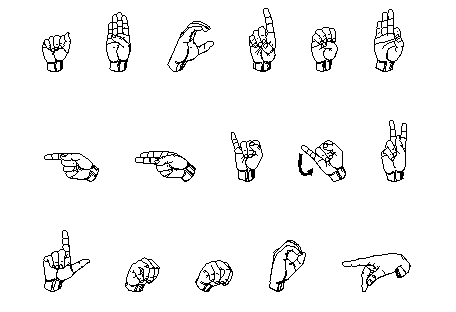
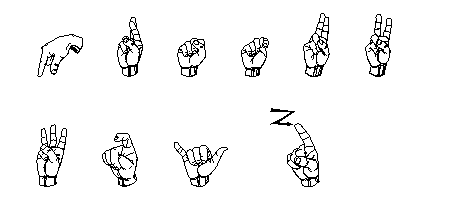
Figure 1 - The Manual Fingerspelling Alphabet
While such tactile reception works fairly well for many
deaf-blind people, it does have significant drawbacks. Since very few people
are skilled in these manual communication techniques, there are very few people
with whom to "talk". The need for interpreters poses still other
problems: locating, procuring, and paying for the interpreter service. A
problem unique to deaf- blind individuals is that many interpreters are
accustomed to being "read" visually by deaf clients and may not be
comfortable with the physical restrictions involved in signing while another
person's hands are touching theirs. In addition, the rapid fatigue resulting
from these tactile methods often requires two interpreters so that a break may
be taken from continuous fingerspelling or signing . The need for an
interpreter may also intrude on the deaf-blind individual's privacy and place
him/her in an extremely dependent situation due to the complete reliance on an
interpreter for any communication.
Method: The first robotic fingerspelling
hand
In an attempt to alleviate these problems, the SouthWest
Research Institute (SWRI) in San Antonio, conceived and developed a mechanical
fingerspelling hand in 1977 [1]. This early device demonstrated the feasibility
of transmitting linguistic information to deaf-blind people by typing messages
on a keyboard connected through electrical logic circuitry to the mechanical
hand. The hand responded by forming the corresponding letters of the one- hand
manual alphabet. To receive the information, the deaf-blind user placed his/her
hand over the mechanical one to feel the finger positions, just as he/she would
with a human fingerspelling interpreter. This system finally enabled deaf-blind
people to receive communications from more than a few select individuals;
anyone who could use a keyboard could express themself to the deaf-blind person
through the mechanical fingerspelling hand.
Result: The first robotic fingerspelling
hand
While the SWRI system demonstrated the concept's
feasibility, it had many technical shortcomings: not all of the letters could
be properly formed, it operated slower than a human interpreter, and the
fluidity of motion which seemed to greatly enhance the intelligibility of
receptive tactile fingerspelling was lacking. In addition, any changes in
timing or how the hand formed the letters had to be achieved through mechanical
alterations of the hardware. This limited the device's flexibility as a
research tool.
Method: Dexter
In 1985, the Rehabilitation Engineering
Center of The Smith-Kettlewell Eye Research Foundation sponsored a class
project conducted by four graduate students in the Department of Mechanical
Engineering at Stanford University to design and fabricate an improved
state-of-the-art fingerspelling hand [2, 3, 4, 5, 6, 7]. Its major goal was to
develop a system with improved timing and easily modifiable finger positions.
These qualities were realized in a new robotic fingerspelling hand named
"Dexter."
|
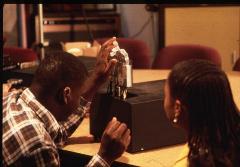 Figure 2 - Dexter
Fingerspelling Hand
|
Dexter's mechanical hardware:
Dexter looked like a mechanical version of a rather large
human hand projecting vertically out of a box. The four machined aluminum
fingers and a thumb were joined together at its palm. All digits operated
independently of each other and had a range of motion comparable to human
fingers. The thumb was jointed so as to allow it to both sweep across the palm
as well as move in a plane perpendicular to it. A pneumatic rotary actuator
allowed the palm to pivot in a rotary fashion around a vertical steel rod much
the way a human hand can pivot from the wrist - except that a full 180 degrees
could be achieved by Dexter.
All Dexter's finger and thumb motions were actuated by
drive cables. Pneumatic cylinders pulled these cables which flexed the
individual fingers and thumb, while spring-driven return cables extended the
fingers. The cylinders, in turn, were activated by air pressure controlled by
electrically operated valves. These valves were controlled by a microcomputer
system. The actuating equipment and valves were housed in two separate
assemblies below the hand.
Dexter's computer hardware:
The original student design was based on an Intel 8085
STD-bus "target system" used in ME218 (Smart Product Design Course)
at Stanford. It consisted of the 8085 microcomputer, Forth programming
language, memory, and counter/timer support. The timer generated the signals
that determined the rate of hand motion and how long each finger position was
to be held. The additional circuitry needed to control Dexter was fabricated on
an STD card which plugged into the target system card cage. A single external
12 volt power supply activated the 22 valves under computer control. Digital
output port latches received data from the CPU, while Darlington power
transistors provided sufficient current to activate the electrically controlled
valves. Letters to be displayed on the hand were entered on an IBM-PC
computer's keyboard which was connected by a serial link to the target
hardware.
Dexter's hardware was subsequently revised at the
Rehabilitation Research and Development Center (RR&D) to consist of a Z80
microprocessor card, two medium-power driver cards, and a high-current DC power
supply all housed in an STD bus card cage. The CPU card itself contained
counter-timers, memory, and serial interfaces. Commercial medium-power DC
driver cards replaced the student-built wire-wrapped version and the power
supply for operating the pneumatic valves was included within the STD chassis.
An Epson HX-20 laptop computer's keyboard and display were employed to
communicate user messages over a serial link to the self-contained target
system.
Dexter's software:
The Forth programming language was chosen because: 1) its
design cycle is approximately eight times shorter than assembly language, 2) it
is an interactive and compact high-level language that can employ assembly
language for critical timing and interrupt service routines, 3) it uses a
standard host computer connected by a serial port to the target hardware for
development, and 4) the application program can be stored in non-volatile
memory after it is fully tested.
The student-designed Forth software was substantially
updated by RR&D to 1) execute from non-volatile memory, 2) accommodate
menu-driven alteration of critical parameters such as timing variables, 3)
allow new characters typed on the keyboard to be accepted while previous ones
were being fingerspelled, and 4) incorporate both modem and serial input of
characters.
Dexter's operation:
The microcomputer and its associated software controlled
the opening and closing of the bank of valves which directed air pressure to
specific pneumatic cylinders which pulled on the drive cables which were the
"tendons" of the fingers. As a message was typed on a keyboard, each
letter's ASCII value was used by the software as a pointer into an array of
stored valve control values. The states (open or closed) of all 22 valves were
specified by three bytes. Two to six valve operations, each separated by a
programmed pause, were needed to specify the finger movements corresponding to
a single letter. The hand could produce approximately two letters per second,
each starting from and returning to a partially flexed neutral position.
An additional bit in the valve control byte triad was
used by the software to determine whether the current finger position was an
intermediate or final letter position. Different programmed pause times were
associated with each of these two situations.
Although the mechanical hand could not exactly mimic the
human hand in fingerspelling all the letters (such as the special wrist and arm
motions required in J and Z), the fact that Dexter always produced the same
motions for a given letter was an important factor influencing its
intelligibility. The inter-letter neutral position was another unnatural
feature of the design that did not accurately reflect human fingerspelling and
limited the speed of letter presentation. Despite these shortcomings, users of
Dexter had little difficulty in accommodating to it.
Result: Testing Dexter
Deaf-blind clients of Lions Blind Center (Oakland, CA)
served as subjects for the initial testing of Dexter. They were able to
identify most of the letters presented by the robotic hand without any
instructions, and in less than an hour were correctly interpreting sentences.
Equally important was their positive emotional reaction to the hand. They
seemed to really enjoy using it and seemed to be intrigued by its novelty.
There were no negative comments made concerning its mechanical nature or any
other aspect of the system.
Method: Dexter-II
Dexter-II was built by a second Stanford
student team in 1988 as a second- generation computer-operated
electro-mechanical fingerspelling hand [8, 9]. This device, like its
predecessor, translated incoming serial ASCII (a computer code representing the
letters and numbers) text into movements of a mechanical hand. Dexter-II's
finger movements were felt by the deaf-blind user and interpreted as the
fingerspelling equivalents of the letters that comprise a message.
Dexter-II was approximately one-tenth the volume of the
original Dexter mechanical system. It was designed by three Stanford graduate
mechanical engineering students and employed DC servo motors to pull the drive
cables of a redesigned hand, thereby eliminating the need for a supply of
compressed gas. A speed of approximately four letters per second, double that
of the original design, could be achieved with the improved design.
|
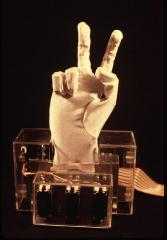 Figure 3 - Dexter-II
Fingerspelling Hand
|
Mechanically, the hand (a right hand the size of a 10
year old) was oriented vertically on top of a enclosure housing the motors.
Each finger could flex independently. In addition, the first finger could move
away from the other three fingers in the plane of the hand (abduction). The
thumb could move out of the plane of the palm (opposition). Finally, the wrist
could flex. Each hand motion was driven by its own servo motor connected to a
pulley. Wire cables anchored at the hand's fingertips and wound around pulleys
served as the finger's "tendons". As the motor shafts were powered,
they turned the pulleys, pulling the cables, to flex the fingers. Torsion
springs at the "knuckles" separating the Delrin finger segments
provided the force to straighten the fingers when the motors released tension
on the cables.
Dexter-II's computer used the STD-bus enclosure, Z80
microprocessor card, and Epson HX-20 computer from Dexter. Two commercial
counter timer cards replaced the medium-power driver cards and were used to
produce the pulse- width modulated waveforms required to control the DC servo
motors. In operation, a message was typed on a keyboard (the Epson HX-20) by an
able- bodied person. Each letter's ASCII value was used by Dexter-II's computer
software to access a memory array of stored control values. This data stream
programmed the pulse-width modulation chips to operate the eight servos and
flex the fingers. The resulting coordinated finger movements and hand positions
were felt by the deaf-blind communicator and interpreted as letters of a
message.
Result: Testing Dexter-II
Dexter-II was first tested by a deaf-blind woman who is
extremely proficient at "reading" tactile fingerspelling. She
provided many suggestions for improving Dexter-II's letter-shape
configurations. Later, it was introduced to twelve deaf-blind people during an
annual retreat in Sacramento.
In June of 1989, about twenty deaf-blind attendees at the
annual Deaf-Blind Conference in Colorado Springs had a chance to experience
Dexter-II. The device was also exhibited at the 1989 RESNA Conference in New
Orleans and at the InvenTech meeting in Anaheim, CA in September, 1989. In all
cases, the deaf-blind individuals' ability to initially understand Dexter-II
varied considerably. Some were able to understand Dexter-II immediately, while
others had trouble translating a few letters.
Although neither Dexter nor Dexter-II could exactly mimic
human hand movements in fingerspelling all the letters, they were able to
display close approximations that have proven to be easy to learn by deaf-blind
users. An advantage of Dexter-II's mechanical system was that it always
produced the same motions for a given letter - an important factor in
recognizing its fingerspelling "accent".
Method: Fingerspelling hand for Gallaudet
In 1992, Gallaudet University
(Washington, DC), with funding from NIDRR, contracted for the design and
construction of two third generation fingerspelling hands for clinical
evaluation [10, 11]. These units were to be smaller, lighter, and more
intelligible than previous designs. The effort involved two facilities:
RR&D Center designed the new mechanical and computer systems, while the
Applied Science and Engineering Laboratories (ASEL) (Wilmington, DE) provided
critical hand position data and addressed telephone interface access
issues.
|
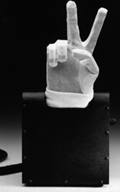 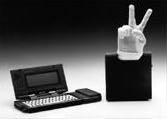 Figure 4 - Fingerspelling Hand for
Gallaudet
|
Fingerspelling hand for Gallaudet mechanical
design:
In this design, as in Dexter-II, each hand motion was
driven by a servo motor connected to a pulley. A cable was wound around the
pulley, routed up the finger, and attached to its tip. The fingers themselves
were constructed of Delrin segments attached to each other by a strip of carbon
fiber. The carbon fiber provided the flexible hinge and restoring force
necessary to extend the finger. When the motor shaft and pulley rotated, the
cable was pulled and the finger flexed. When the motor shaft rotated in the
other direction, the tension on the cable was released and the finger
straightened.
Fingerspelling hand for Gallaudet computer hardware
design:
A Z180 SmartBlock (Z-World, Davis, CA) 8 bit
microcontroller accepted RS232 serial data and choreographed hand motion by
controlling eight DC servo motors. The controller itself was compact enough to
be packaged within the hand's enclosure.
Fingerspelling hand for Gallaudet computer software
design:
The Forth programming language provided a simple user
interface, allowed modifications to the finger positions, and permitted the
system parameters to be altered. Fingerspelling movements in this version were
much more fluid due to the elimination of the inter-letter neutral position.
The software includes two finger position tables for each letter pair. One
table is permanently installed, while the other can be altered using a built-in
editor. This facility permits movements to be changed to enhance a particular
letter pair's readability. Fingerspelling speed was adjusted by a six position
rotary switch. The first five positions selected increasing speeds by altering
the length of the pauses between letters, while the final position offered a
programmable speed.
Result: Fingerspelling hand for Gallaudet testing and
evaluation
ASEL tested and configured the fingerspelling hands for
use with TDDs. The letters were further optimized for improved recognition.
Nine deaf-blind people tested the hands over a two month period at Gallaudet.
One individual was able to interpret all ten simple sentences without error.
Other users were able to understand 70% of the sentences. Comparable
performance was achieved with single isolated letters. The users identified
confusing letter combinations and suggested improvements for a commercial
prototype [12].
Method: Ralph
A fourth generation fingerspelling hand
called Ralph (for Robotic ALPHabet) has been constructed by RR&D to serve
as a basis for technology transfer and commercialization. Specifically, this
design implemented an improved mechanical system.
Ralph's mechanical design:
Ralph's design is similar to the hands designed for
Gallaudet. In this device, however, a new mechanical system replaces the
pulleys and carbon fiber strips. Each hand motion is driven by a servo motor
connected by a lever arm to a rod. The rods push and pull a system of linkages
that flexes the individual fingers and the wrist. The elimination of the
pulleys makes Ralph more compact and able to fingerspell faster. Its fingers
are actively extended, unlike Dexter-II or the Gallaudet hands.
|
 Figure 5 - Ralph
Fingerspelling Hand
|
Ralph's computer design:
Ralph utilizes the same computer hardware as its
predecessor and its Forth software is organized in 17 modules. These modules
provide enhancements for the Forth kernel, an assembler (including routines
that implement special I/O instructions used by the microcontroller), an ANSI
display driver, serial port utilities, timer port utilities, clock utilities,
servo motor pulse width modulation generation, speed switch driver, interrupt
routines, input buffer software, timing control, hand data storage,
fingerspelling algorithm, hand position editing support, and the user
interface. As with the Gallaudet hand, Ralph's software provides a menu-driven
user interface, allows the finger positions to be edited, and permits
alteration of system parameters.
Ralph's operation:
Any device that produces RS232 serial data, including
terminals, modems, computers, OCR scanners, speech recognizers, or modified
closed caption systems, could be used to control Ralph. The user interface is
implemented as a menu system which provides easy access to the unit's various
functions including displaying and setting the microcontroller's parameters,
testing the hand motions, editing hand position data, and entering letters to
be fingerspelled.
In the fingerspelling mode, keypresses are entered on the
keyboard. The hand's software translates these keypresses into commands for the
DC servo motors. As the motor shafts rotate, they push/pull on the rods that
connect to the fingers' mechanical linkages. It is by this coordinated series
of motor commands that keyboard input is transformed into choreographed motion
representing fingerspelling.
The mechanical system provides sufficient torque to move
the fingers against the resistance of a user's hand, but not enough to cause
any pain or injury if the user's finger happen to get caught under Ralph's. The
servo motors simply stall when their torque limit is exceeded.
Result: Ralph's testing and evaluation
Over a two-day period at ASEL, Ralph was evaluated for
approximately 8 hours by two individuals. One was familiar with the Gallaudet
fingerspelling hand and was completely deaf and blind. The other had not used
mechanical fingerspelling hands before and had some residual sight and hearing
capabilities.
They both reported trouble with some letters, but the
first user was able to correctly identify isolated characters over 75% of the
time.
When short sentences were presented, the experienced user
completely understood approximately 75% of the sentences. Furthermore, in each
of the failures, after a second presentation, the sentence was either
understood in its entirety or just one key word was misidentified.
Additionally, both users appreciated the new rounded
design of Ralph's finger segments because they felt more natural than the hands
built for Gallaudet.
Discussion: Technology transfer
Beyond evaluation, technology transfer issues must be
addressed. The market for fingerspelling hands needs to be assessed. A
collaborative effort with a manufacturer will be required to move this device
out of the laboratory and into the hands of deaf-blind people. A potential
manufacturer has been found in southern California. Current plans involve
pursuing Small Business Innovative Research (SBIR) funding for technology
transfer and the additional design changes to address remaining concerns
identified during Gallaudet's evaluation.
A potential solution exists for the provision of
fingerspelling hands to deaf-blind people. Within California (and some other
states), all telephone subscribers support a fund which provides telephone
access equipment for persons with disabilities. Under this program, approved
commercial versions of this fingerspelling hand could be furnished at no charge
to deaf-blind people.
Research has also been done on a "Talking
Glove" [13]. This device consisted of an instrumented glove worn by a
deaf-blind person that sensed the flex of each finger. Its pattern matching
software translated the wearer's fingerspelling gestures into letters which
could be displayed or vocalized by a speech synthesizer. This system could
provide an expressive communication channel for Ralph's users.
Conclusion:
Ralph was intended to serve deaf-blind users as a
complete receptive communication system, not just a means of receiving
information in face-to- face situations. Its ability to respond to computer
input means it can be interfaced to a TDD to provide deaf-blind people with
telephone communication. It can also be connected to computers to provide
improved vocational and avocational potential to the deaf-blind
community.
All encounters with Ralph and previous fingerspelling
hands have been enthusiastic, positive, and at times, highly emotional. The
increased communication capability and ability to "talk" directly
with people other than interpreters are powerful motivations for using
fingerspelling hands. They have the potential to provide deaf-blind users with
untiring personal communication at rates approaching that of a human
interpreter.
A commercially available product may help alleviate some
of the extreme isolation experienced by people who are deaf and blind. It is a
device which performs a worthy task - that of enabling human beings to
communicate with each other.
References:
| 1. |
Laenger, Charles J., Sr.; and Peel, H.
Herbert, `Further Development and Tests of an Artificial Hand for Communication
With Deaf-Blind People', Southwest Research Institute, March 31,
1978. |
2. |
Danssaert, John; Greenstein, Alan; Lee, Patricia; and Meade, Alex, `A
Finger-Spelling Hand for the Deaf-Blind, ME210 Final Report', Stanford
University, June 10, 1985. |
3. |
Gilden, Deborah, `A Robotic Hand as a Communication Aid for the Deaf- Blind',
Proceedings of the Twentieth Hawaii International Conference on System
Sciences, 1987. |
4. |
Gilden, Deborah and Jaffe, David L., `Dexter - A Mechanical Finger- Spelling
Hand for the Deaf-Blind', Rehabilitation Research and Development Center
Progress Reports, 1986. |
5. |
Gilden, Deborah and Jaffe, David L., `Dexter - A Helping Hand for Communicating
with the Deaf-Blind', Ninth Annual RESNA Conference, Minneapolis, MN,
1986. |
6. |
Jaffe, David L., `Speaking in Hands', SOMA: Engineering for the Human Body,
Volume 2, Number 3, October, 1987, pp 6-13. |
7. |
Gilden, Deborah and Jaffe, David L., `Dexter - a Robotic Hand Communication Aid
for the Deaf-Blind', International Journal of Rehabilitation Research, 1988, II
(2), pp198-199. |
8. |
Jaffe, David L., `Dexter II - The Next Generation Mechanical Fingerspelling
Hand for Deaf-Blind Persons', Proceedings of the 12th Annual RESNA Conference,
New Orleans, June, 1989. |
9. |
Jaffe, David L., `Dexter - A Fingerspelling Hand', OnCenter - Technology
Transfer News, Volume 1, Number 1, June, 1989. |
10. |
Jaffe, David L., `Third Generation Fingerspelling Hand', Proceedings of the
Technology and Persons with Disabilities Conference, Los Angeles, CA, March,
1993. |
11. |
Jaffe, David L., `The Development of a Third Generation Fingerspelling Hand',
16th Annual RESNA Conference, Las Vegas, NV, June, 1993. |
12. |
Harkins, Judith E., Korres, Ellie, and Jensema, Carl J., `Final Report - A
Robotic Fingerspelling Hand for Communication and Access to Text for Deaf-Blind
People', Gallaudet University, 1993. |
13. |
Kramer, James and Leifer, Larry, `An Expressive and Receptive Communication Aid
for the Deaf, Deaf-Blind, and Nonvocal', Proceedings of the Annual Conference,
IEEE Engineering in Medicine and Biology Society, Boston, 1987. |
Other references:
Ouellette, S., `Deaf-blind Population Estimates', In D.
Watson, S. Barrett, and R. Brown (Eds.), A Model Service Delivery System for
Deaf-Blind Persons. Little Rock, AK: University of Arkansas, Rehabilitation
Research and Training Center on Deafness/Hearing Impairment., (not
dated).
Reed, C.M., Delhorne, L.A., Durlach, N.I., and Fischer,
S.D., `A Study of the Tactual and Visual Reception of Fingerspelling', Journal
of Speech and Hearing Research, 33, 786-797.
Funding:
Dexter's design and development was conducted under
DOE-NIHR Grant No. G008005054, with assistance from The Smith-Kettlewell Eye
Research Foundation.
Dexter II was developed with VA RR&D Core
funding.
Gallaudet Hand support was provided by NIDRR (Project
H133G80189-90) under contract to PAIRE (Palo Alto Institute for Research and
Education) and supervised by Gallaudet University.
Ralph was supported by VA RR&D Core funds through its
Technology Transfer Section.
Acknowledgements:
The following people and facilities were involved in the
evolution of mechanical fingerspelling hands. This effort would not have been
possible without their ideas, energy, and commitment.
- Rehabilitation Research and Development Center
- David L. Jaffe
- Douglas F. Schwandt
- James H. Anderson
- Stanford student group - Dexter
- John Danssaert
- Alan Greenstein
- Patricia Lee
- Alex Meade
- Stanford student group - Dexter II
- David Fleming
- Gregory Walker
- Sheryl Horn
- Smith-Kettlewell Eye Research
- Deborah Gilden
- Gallaudet University
- Judith E. Harkins
- Ellie Korres
- Carl J. Jensema
- Applied Science and Engineering Laboratories
- Richard Foulds
- William Harwin
- Timothy Gove
- Palo Alto Institute for Research and Education
- David D. Thomas
- University of Capetown Medical Center
- David A. Boonzaier
|